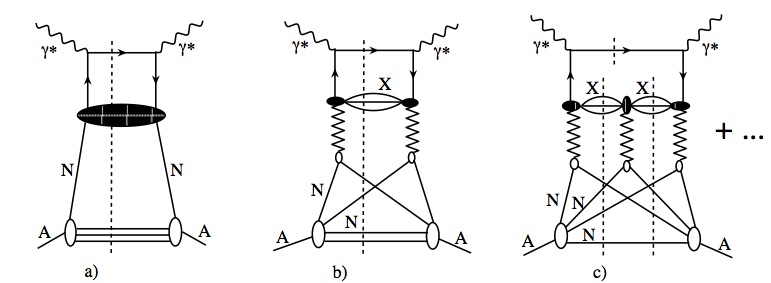Predictions for nPDFs Predictions for impact parameter dependent nPDFs Nuclear diffractive PDFs
Back to V. Guzey at PNPI
Overview of the formalism
The leading twist model of nuclear shadowing predicts the x, Q2, and impact parameter b dependence of sea quark and gluon nuclear parton distribution functions (nPDFs) at the next-to-leading order (NLO) and at the leading order (LO).Fortran codes and required data files with grids for nuclear PDFs, impact parameter dependent nuclear PDFs, and diffractive nuclear PDFs can be found following the corresponding links on the left. To summarize our approach, using the formalism outlined below, we calculate the sea quark and gluon parton distributions (PDFs) in nuclei in the shadowing region, 10-5 ≤ x ≤ 0.1, at the initial scale Q02=4 GeV2. In this region of small Bjorken x, nuclear PDFs fj/A(x,Q2) (j is the parton flavor) are suppressed compared to the corresponding sum of the PDFs of the free nucleons, fj/N(x,Q2), i.e., fj/A(x,Q2) < A fj/N(x,Q2). This suppression is called nuclear shadowing.
In the interval 0.1 < x < 0.2, nuclear PDFs are enhanced compared to a sum of free nucleon PDFs -- this is called antishadowing. We assume no antishadowing for the sea quarks; antishadowing for the gluons is modeled on the interval 0.03 < x < 0.1 by requiring the conservation of the momentum sum rule for nuclear PDFs. We do not apply our approach to valence quark nPDFs since nuclear shadowing in the valence channel originates mainly from interference between the exchanges with the Pomeron and Reggeon quantum numbers; the latter is essentially unknown. Hence, for the valence quark nPDFs, we use the results of the global QCD fits from K.J. Eskola, V.J. Kolhinen and P.V. Ruuskanen, "Scale evolution of nuclear parton distributions", Nucl. Phys. B 535 (1998) 351. This specifies nPDFs at some input scale, Q02 (Q02=4 GeV2 in our case). Predictions for nPDFs at an arbitrary scale Q2 ≥ Q02 are obtained using the DGLAP QCD evolution. The leading twist model of nuclear shadowing is based on the following three ingredients:
- Generalization of the Gribov-Glauber multiple scattering formalism for soft hadron-deuteron scattering to deep inelastic scattering (DIS) off arbitrary nuclei
- QCD factorization theorems (the leading twist approximation) for inclusive DIS and hard diffraction in DIS
- QCD analyses of hard diffraction in ep DIS at HERA.
- experimental uncertainty (at the level of 15%) in the slope of the t dependence of the ep diffractive structure function, Bdiff
- uncertainty in the rescattering cross section σsoftj which is needed to model interactions with N ≥ 3 nucleons of the nucleus.
 where TA(b) is the nuclear optical density.
where TA(b) is the nuclear optical density.
Fortran codes and required data files with grids for nuclear PDFs, impact parameter dependent nuclear PDFs, and diffractive nuclear PDFs can be found following the corresponding links on the left.

